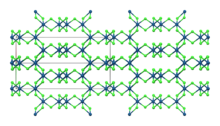Iridium(III) chloride
 α-IrCl3
| |
 β-IrCl3
| |
| Names | |
|---|---|
| Other names
Iridium trichloride
| |
| Identifiers | |
| |
3D model (JSmol)
|
|
| ChemSpider | |
| ECHA InfoCard | 100.030.028 |
| EC Number |
|
PubChem CID
|
|
| UNII | |
CompTox Dashboard (EPA)
|
|
| |
| |
| Properties | |
| IrCl3 | |
| Molar mass | 298.58 g/mol (anhydrous) |
| Appearance | dark green solid hygroscopic |
| Density | 5.30 g/cm3, solid |
| Melting point | 763 °C (1,405 °F; 1,036 K) (decomposes) |
| insoluble (anhydrous IrCl3), soluble (hydrated derivative) | |
| −14.4·10−6 cm3/mol | |
| Structure | |
| Monoclinic, mS16 | |
| C12/m1, No. 12 | |
| Thermochemistry | |
Std enthalpy of
formation (ΔfH⦵298) |
-257 kJ/mol |
| Hazards | |
| GHS labelling:[1] | |
 
| |
Signal word
|
Warning |
| H302, H411 | |
| Flash point | non-flammable |
| Related compounds | |
Other cations
|
Rhodium(III) chloride |
Related compounds
|
Platinum(II) chloride |
Except where otherwise noted, data are given for materials in their standard state (at 25 °C [77 °F], 100 kPa). | |
| Infobox references | |
Iridium(III) chloride is the inorganic compound with the formula IrCl3. The anhydrous compound is relatively rare, but the related hydrate is useful for preparing other iridium compounds. The anhydrous salt is a dark green crystalline solid. More commonly encountered is the trihydrate IrCl3(H2O)3.
Preparation[]
Iridium is separated from the other platinum group metals as crystalline ammonium hexachloroiridate, (NH4)2[IrCl6], which can be reduced to iridium metal in a stream of hydrogen. The spongy Ir thus produced reacts with chlorine at 300–400 °C to give iridium(III) chloride.
Hydrated iridium trichloride is obtained by heating hydrated iridium(III) oxide with hydrochloric acid.
Structure[]
Like the related rhodium compound, IrCl3 adopts the structure seen for aluminium chloride.[2] This is the monoclinic α polymorph.[3] A rhombohedral β polymorph also exists. Both polymorphs have effectively the same anion lattice but differ in the octahedral interstices the iridium ions occupy.[4]
Uses[]
Industrially, most iridium complexes are generated from ammonium hexachloroiridate or the related chloroiridic acid (H2IrCl6) as these salts are the most common commercial forms of iridium chlorides.
Hydrated iridium(III) chloride is used in the laboratory for the preparation of other iridium compounds such as Vaska's complex, trans-[IrCl(CO)(PPh3)2].[5] Alkene complexes such as cyclooctadiene iridium chloride dimer[6][7] and chlorobis(cyclooctene)iridium dimer[7][6] can also be prepared by heating the trichloride with the appropriate alkene in water/alcohol mixtures.
Safety[]
Iridium(III) chloride is not listed under Annex I of Directive 67/548/EEC, but is listed in the inventory of the Toxic Substances Control Act (TSCA).
References[]
- ^ "C&L Inventory". echa.europa.eu. Retrieved 23 December 2021.
- ^ Greenwood, Norman N.; Earnshaw, Alan (1997). Chemistry of the Elements (2nd ed.). Butterworth-Heinemann. ISBN 978-0-08-037941-8.
- ^ Brodersen, K.; Moers, F.; Schnering, H. G. (1965). "Zur Struktur des Iridium(III)- und des Ruthenium(III)-chlorids". Naturwissenschaften. 52 (9): 205–206. doi:10.1007/BF00626459. S2CID 43351743.
- ^ Meisel, A.; Leonhardt, G. (1965). "Die Kristallstruktur von β-Iridium(III)-Chlorid". Z. Anorg. Allg. Chem. 339 (1–2): 57–66. doi:10.1002/zaac.19653390109.
- ^ Vaska, L.; & DiLuzio, J. W. (1961) J. Am. Chem. Soc. 83:2784. Girolami, G.S.; Rauchfuss, T.B.; Angelici, R.J. (1999). Synthesis and Technique in Inorganic Chemistry (3rd Edn.). Sausalito:University Science Books.
- ^ a b Winkhaus, G.; & Singer, H. (1966). Iridium(I)-Olefinkomplexe. Chem. Ber. 99:3610–18.
- ^ a b Herde, J. L.; Lambert, J. C.; & Senoff, C. V. (1974). Cyclooctene and 1,5-Cyclooctadiene Complexes of Iridium(I). Inorg. Synth. 1974, volume 15, pages 18–20. doi:10.1002/9780470132463.ch5.
- Chlorides
- Iridium compounds
- Platinum group halides